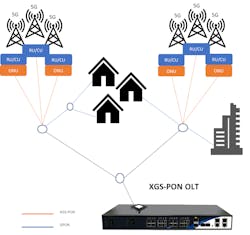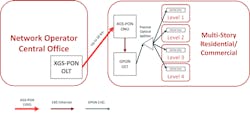The Secret Sauce to REALLY Deploying 5G Nationwide
To drive and sustain the required high bandwidth of 5G, wireless radio channels must be adjusted toward using a millimeter-wave band. Although millimeter-wave can support higher capacities and large throughputs, its major drawback is distance. The signal radius is reduced from as much as a kilometer in 4G networks to 100 meters or less, depending on the terrain and weather conditions.
As a result, 5G requires more access points for the same coverage as 4G. The estimates are that 5 to 10 times more antennas will be required by 2026 to achieve complete 5G penetration, which translates to tens of millions of towers globally. (Source: https://www.ctia.org/the-wireless-industry/infographics-library?topic=17)
Despite frequent claims to the contrary by the largest telecom operators, there is no such thing as a nationwide network for 5G yet because there simply are not enough towers in place to provide the necessary coverage. Mass deployment of base stations in a dense enough network is a major infrastructural challenge that is rarely discussed openly regarding 5G networks.
And even once such a network is in place, how are all these towers going to be connected?
“In many countries, fiber-to-the-room (FTTR) is becoming a solution to Wi-Fi challenges. FTTR addresses Wi-Fi issues by bringing PON not just to the edge of the building, but also extends it within the structure to the various floors of the facility.”
Why is 5G Different?
In legacy 4G network architecture, base stations were usually co-located with each tower, taking up a lot of physical space for the antenna, radio unit, and baseband unit, as well as power supply, backup battery, and temperature control. Given the significantly greater number of towers that it requires, a 5G network, on the other hand, separates the data processing within the distributed unit (DU) from the signal-bearing radio unit (RU), moving the DUs to telco central offices at the edge of the access network in order to reduce both the size and cost of the base stations.
The main backhaul element for connectivity in most 4G cell towers is microwave technology. 5G networks, though, will be deployed based on cloud RAN topology, in which data will run directly over fiber from antennas towards the DUs, requiring 10 Gbps to 25 Gbps connections, a difficult task for microwave to bear. Moreover, physically separating the DU from the RU necessitates much greater reliance on high-capacity fiber to bridge them and to meet 5G standards, which can reach as much as 20 times the required capacity of 4G LTE, not to mention the need for extremely low latency of up to 10 times less delay than LTE.
One option is to lay all new fiber to connect these millions of radio towers, but that would take an inordinate amount of time and major added cost that operators cannot afford. A different solution must be found to address the logistical constraints and the tremendous infrastructure expenses of implementing the 5G network—one that optimizes the cost of deploying towers and the last-mile transport to reach the base stations.
PON for 5G
The most logical solution maximizes capacity within the radio access network (RAN) by exploiting existing fiber infrastructure. The answer is passive optical networks (PON), which are already available for fiber-to-the-home connectivity, and which can enable the 5G data to be transported via fiber from the radio towers to the RAN. (See Figure 1.)
PON is agile and reliable, and it is efficient enough to provide fronthaul transport for both cellular and fixed broadband within a single network. That offers a tremendous advantage over other distribution networks that require alternative types of distribution for different technologies.
For 5G to also reach home and enterprise sites, there must also be connections from the millions of radio antennas to the RAN. Operators can reduce the number of trunk fibers that are used by implementing an architecture based on the point-to-multipoint tree topology of PON.
The large, extensive existing FTTx networks have sufficient line and port resources, plus the required optical devices and power supply. PON maintains connectivity even if a line is disconnected, offering a resilience that cannot be matched by many other transport options. Perhaps most importantly, PON reuses existing fiber and optical filters, lowering networking costs, and it handles various traffic streams with greater capacity than the alternatives.
Thus, because it offers both a cost-effective solution and optimal performance, the ideal conduit for transporting 5G traffic from the RUs to the DUs and perhaps even onward to the rest of the access network, is existing PON fiber.
FTTR for Multi-Story Connectivity
COVID-19 proved how critical a high-performance Internet connection is in today’s world. Students learned remotely, employees began to telecommute, online shopping became more prevalent, and telehealth gained popularity. The common denominator among these trends was the need for high-speed, low-latency Internet, which is not a given for many homes and small businesses.
While the world has largely returned to its routine, many of our behavioral changes have stuck. We have come to expect a certain standard of service from our broadband—valuing reliability and performance over price.
FTTx has been viewed as a viable answer because fiber promises much faster overall Internet speeds. The issue, though, is that Wi-Fi presents a bottleneck within a multi-floor facility such as an apartment building, hotel, or business. Its signal often struggles to reach distant rooms around corners, on different floors, or through walls, and it can also suffer from interference with neighboring Wi-Fi networks and microwaves. Moreover, a complex Wi-Fi network in a hotel or business can prove difficult to manage.
In many countries, fiber-to-the-room (FTTR) is becoming a solution to Wi-Fi challenges. FTTR addresses Wi-Fi issues by bringing PON not just to the edge of the building, but also extends it within the structure to the various floors of the facility.
FTTR is an exceptionally smart option for new construction, when the fiber can potentially reach multiple levels from the outset, allowing for higher speed Internet (upwards of 1 Gbps) throughout the facility that is more reliable than Ethernet or coaxial cable. In Brownfield applications, laying fiber within the walls of the building is a bit more involved. PON can still be leveraged by running it within the building’s existing electrical tunneling. (See Figure 2.)
Once PON is deployed via FTTR, it offers benefits for both end users and operators:
- For end users, FTTR ensures that they receive the level of Internet performance that they require, enabling multiple people within the same building to run live video conferencing streams simultaneously, without experiencing lags to the service.
- For operators, FTTR continues to take advantage of the existing PON infrastructure, while creating valuable opportunities for service upgrades for their customers, in turn allowing them to charge more per user. They can promote premium value-added services, such as augmented reality, virtual reality, metaverse, and other bandwidth-hungry applications, which would not be possible without PON’s reliability and high performance.
The Secret Sauces?
PON differentiates itself to telecom providers as an optimal 5G fronthaul transport option and as a reliable, high bandwidth means of providing access within the multi-story residential or enterprise facility. It is already widely available and offers a single distribution network for both fixed broadband and cellular data transport. It can also scale, be configured simply based on demand, and it interoperates well with other networking architectures.
Ultimately, though, PON optimizes operator costs by using existing infrastructure, which is crucial when so much time and expense is being allocated toward implementing the dense network of towers that provide the backbone for 5G.
About the Author
David Levi
CEO and Founder, Ethernity Networks
David Levi is the CEO and Founder of Ethernity Networks. Prior to Ethernity, David was granted two US patents regarding GPON protocol-related inventions. He founded Broadlight, which created BPON and GPON components and was acquired by Broadcom. For more information, email [email protected] or visit https://ethernitynet.com/. Follow them on Twitter @EthernityN and LinkedIn: https://www.linkedin.com/company/ethernity-networks/.



